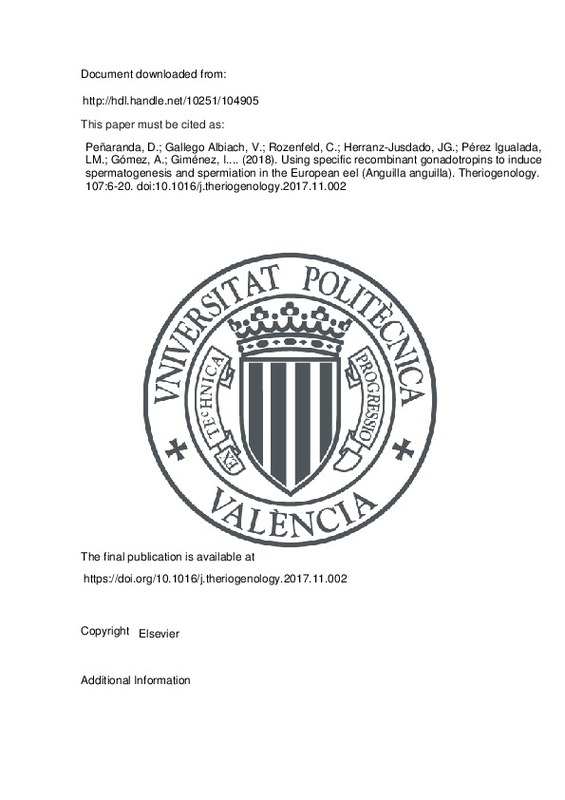JavaScript is disabled for your browser. Some features of this site may not work without it.
Buscar en RiuNet
Listar
Mi cuenta
Estadísticas
Ayuda RiuNet
Admin. UPV
Using specific recombinant gonadotropins to induce spermatogenesis and spermiation in the European eel (Anguilla anguilla)
Mostrar el registro sencillo del ítem
Ficheros en el ítem
| dc.contributor.author | Peñaranda, D.S.
|
es_ES |
| dc.contributor.author | Gallego Albiach, Victor
|
es_ES |
| dc.contributor.author | Rozenfeld, Christoffer
|
es_ES |
| dc.contributor.author | Herranz-Jusdado, Juan Germán
|
es_ES |
| dc.contributor.author | Pérez Igualada, Luz María
|
es_ES |
| dc.contributor.author | Gómez, A.
|
es_ES |
| dc.contributor.author | Giménez, I.
|
es_ES |
| dc.contributor.author | Asturiano Nemesio, Juan Francisco
|
es_ES |
| dc.date.accessioned | 2018-07-02T04:23:13Z | |
| dc.date.available | 2018-07-02T04:23:13Z | |
| dc.date.issued | 2018 | es_ES |
| dc.identifier.issn | 0093-691X | es_ES |
| dc.identifier.uri | http://hdl.handle.net/10251/104905 | |
| dc.description.abstract | [EN] New specific European eel (Anguilla anguilla) recombinant gonadotropins (aarGths) produced in the ovarian cells of Chinese hamsters (CHO) were used to induce maturation in captive male eels. In the first experiment, five different hormonal treatments were assayed: one group was given a constant dose of recombinant European eel follicle-stimulating hormone (aarFsh; 4 ¿g/fish) for 9 weeks, and the second group received a constant dose of recombinant European eel luteinizing hormone (aarLh; 2 ¿g/fish) also for 9 weeks. The other three groups were injected with different combinations of both aarGths (some doses constant, some variable). All five treatments stimulated androgen synthesis, but the increase was more pronounced in the fish treated with a combination of both aarGths. Unlike aarLh, aarFsh alone was able to induce spermiation, the best results were achieved in the fish that were treated with a constant dose of aarFSH and an increasing dose of aarLH, with spermiation being induced (20% motile cells) despite the fact that these fish were immature at the start of the experiment. In order to improve sperm quality, a second experiment was performed. Immature males received three constant doses of aarFsh (2.8, 1.4 or 0.7 ¿g/fish) and increasing doses of aarLh (every 3 weeks; 1, 2, 6 ¿g/fish). All the treatments induced spermiation, however the best sperm quality (with ¿50% motile cells) was observed in the males treated with the highest dose of aarFsh. In conclusion, these specific recombinant gonadotropins have demonstrated their capacity to induce spermatogenesis and spermiation in vivo in a teleost fish, the European eel. | es_ES |
| dc.description.sponsorship | This project has received funding from the European Union's Horizon 2020 research and innovation programme under the Marie Sklodowska-Curie grant agreement No 642893 (EN IMPRESS), the Spanish Ministry of Economy, Industry and Competitiveness (Project REPRO-TEMP; AGL2013-41646-R), Generalitat Valenciana (PROMETEOII/2014/051), VLC/CAMPUS Program (SP20140630) and the COST Office (COST Action FA1205: AQUAGAMETE). VG has a postdoc grant from the UPV (PAID-10-14). We would like to thank M.S. Ibanez for carrying out the ELISAs. | en_EN |
| dc.language | Inglés | es_ES |
| dc.publisher | Elsevier | es_ES |
| dc.relation.ispartof | Theriogenology | es_ES |
| dc.rights | Reserva de todos los derechos | es_ES |
| dc.subject | aarFsh | es_ES |
| dc.subject | aarLh | es_ES |
| dc.subject | Maturation | es_ES |
| dc.subject | Sperm | es_ES |
| dc.subject | Testis | es_ES |
| dc.subject.classification | BIOLOGIA ANIMAL | es_ES |
| dc.subject.classification | PRODUCCION ANIMAL | es_ES |
| dc.title | Using specific recombinant gonadotropins to induce spermatogenesis and spermiation in the European eel (Anguilla anguilla) | es_ES |
| dc.type | Artículo | es_ES |
| dc.identifier.doi | 10.1016/j.theriogenology.2017.11.002 | es_ES |
| dc.relation.projectID | info:eu-repo/grantAgreement/EC/H2020/642893/EU/Improved production strategies for endangered freshwater species./ | es_ES |
| dc.relation.projectID | info:eu-repo/grantAgreement/UPV//PAID-10-14/ | es_ES |
| dc.relation.projectID | info:eu-repo/grantAgreement/COST//FA1205/EU/Assessing and improving the quality of aquatic animal gametes to enhance aquatic resources - The need to harmonize and standardize evolving methodologies, and improve transfer from academia to industry/ | es_ES |
| dc.relation.projectID | info:eu-repo/grantAgreement/UPV//SP20140630/ | es_ES |
| dc.relation.projectID | info:eu-repo/grantAgreement/MINECO//AGL2013-41646-R/ES/LA ANGUILA EUROPEA COMO MODELO PARA ESTUDIAR LA TEMPERATURA COMO MODULADOR DE LA MADURACION SEXUAL EN TELEOSTEOS. POTENCIAL APLICACION EN ACUICULTURA./ | es_ES |
| dc.rights.accessRights | Abierto | es_ES |
| dc.date.embargoEndDate | 2019-02-01 | es_ES |
| dc.contributor.affiliation | Universitat Politècnica de València. Instituto de Ciencia y Tecnología Animal - Institut de Ciència i Tecnologia Animal | es_ES |
| dc.contributor.affiliation | Universitat Politècnica de València. Departamento de Ciencia Animal - Departament de Ciència Animal | es_ES |
| dc.description.bibliographicCitation | Peñaranda, D.; Gallego Albiach, V.; Rozenfeld, C.; Herranz-Jusdado, JG.; Pérez Igualada, LM.; Gómez, A.; Giménez, I.... (2018). Using specific recombinant gonadotropins to induce spermatogenesis and spermiation in the European eel (Anguilla anguilla). Theriogenology. 107:6-20. https://doi.org/10.1016/j.theriogenology.2017.11.002 | es_ES |
| dc.description.accrualMethod | S | es_ES |
| dc.relation.publisherversion | https://doi.org/10.1016/j.theriogenology.2017.11.002 | es_ES |
| dc.description.upvformatpinicio | 6 | es_ES |
| dc.description.upvformatpfin | 20 | es_ES |
| dc.type.version | info:eu-repo/semantics/publishedVersion | es_ES |
| dc.description.volume | 107 | es_ES |
| dc.relation.pasarela | S\345867 | es_ES |
| dc.contributor.funder | Universitat Politècnica de València | es_ES |
| dc.contributor.funder | European Cooperation in Science and Technology | es_ES |
| dc.contributor.funder | European Commission | es_ES |
| dc.contributor.funder | Ministerio de Economía, Industria y Competitividad | es_ES |







![[Cerrado]](/themes/UPV/images/candado.png)

